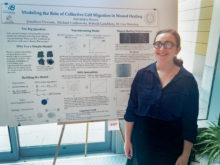Undergraduate Researcher Excels with Research Computing Help
This past summer, SU Professor Lisa Manning advised undergraduate student Alexandra Brown on a computational physics project as part of a research experience for undergraduate (REU) program hosted by the Syracuse Biomaterials Institute (SBI).
This program, which invited 13 undergraduate researchers in 2016, has been running since 2010 and is currently under the direction of Jay Henderson (Associate Professor, Department of Biomedical and Chemical Engineering), Julie Hasenwinkel (Professor, Department of Biomedical and Chemical EngineeringSyracuse Biomaterials Institute).
Learn more as Associate Professor Lisa Manning answers questions about this program

What is the Research Experiences for Undergraduates (REU) program?
This is a program funded by the NSF that brings undergraduates to work in science labs over the summer. Our REU program is run through the Syracuse Biomaterials Institute under the direction of Jay Henderson and Julie Hasenwinkle.
Where do the participantsin the program originate from and how were they selected?
The students in the program are from universities and colleges all over the country. They apply for these highly competitive slots in February (applications include transcripts, research statements, letters of recommendation), and they are selected by a team of faculty members at SU. Therefore they really are the best of the best. Alexandra Brown, an undergraduate at St. Michael’s College in Vermont, was selected to join our group for the 10 week program this summer.
What research work were the participants involved in?
Alexandra used a mathematical model to study the behavior of biological tissues, specifically in the context of wound healing. With mentoring from me, as well as graduate students and postdocs, she taught herself how to code, wrote a computer program to simulate cells, and analyzed the behavior of that model. Eventually, our goal is to compare those results to experiments on wound healing in the Henderson lab (SU BMCE) and Turner lab (Cell and Developmental Biology, Upstate).
What types of resources did the participants utilize during the REU program?
Alexandra used a laptop managed by CAS ITS, with some additional programs added and managed by the Biomaterials Institute , as well as the smatter virtual cluster inside crush. (Smatter is a dynamic virtual compute cluster residing within the Academic Virtual
Hosting Environment and Crush Cloud at Syracuse University.)
What outcomes do you expect for participants that complete the program?
We expect that the REU experience will help students get engaged in scientific research early in their careers and give them a boost in deciding about future career paths in academia or industry. We also provide alot of professional development training (how to give talks, network, develop technical writing skills, give poster presentations, learn scientific method. In particular, I believe that Alexandra’s experience helped her to decide she wants to go to graduate school in physics, which is great, because women are underrepresented in this field.
Learn more here about the NSF grants:
- REU grant: NSF DMR-1460784 (REU)
- Lisa Manning’s CAREER award: NSF-DMR-1352184 (NSF CAREER)
- Joint grant with Jay Henderson and Chris Turner: NSF-CMMI-1334611
